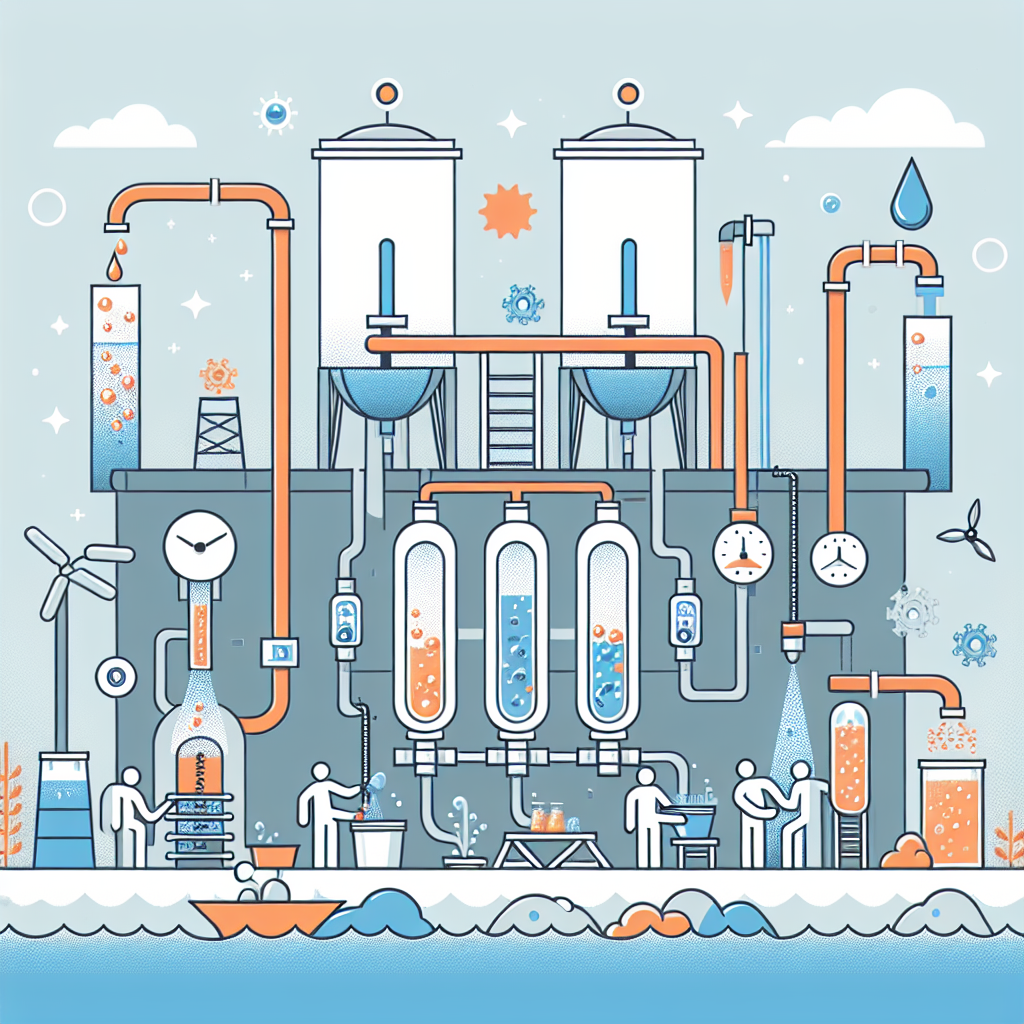The Electrochlorination Process: An In-Depth Exploration
Introduction to Electrochlorination
Electrochlorination is a vital process used primarily for the generation of sodium hypochlorite (NaOCl), an effective disinfectant and bleaching agent widely used across various industries, including water treatment, food processing, and swimming pool sanitation. The technique involves the electrolytic conversion of saltwater (brine) into chlorine and its subsequent combination with water to form hypochlorite ions. The growing demand for effective and environmentally friendly disinfection methods has led to an increased interest in electrochlorination technology, particularly as a sustainable alternative to conventional chlorine gas handling and storage.
This article delves into the electrochlorination process, its underlying chemistry, its applications, advantages, and challenges, and its role in promoting sustainability in water treatment.
The Chemistry of Electrochlorination
1. The Fundamental Reaction
The electrochlorination process occurs in an electrochemical cell where an electric current is passed through a brine solution (usually composed of sodium chloride and water). The fundamental reaction can be summarized as follows:
-
Electrolysis of Brine:
- At the anode (positive electrode), chloride ions (Cl⁻) are oxidized to form chlorine gas (Cl₂):
[
2Cl⁻ \rightarrow Cl₂(g) + 2e⁻
]
- At the anode (positive electrode), chloride ions (Cl⁻) are oxidized to form chlorine gas (Cl₂):
-
Formation of Hypochlorous Acid:
- At the cathode (negative electrode), water is reduced to form hydroxyl ions (OH⁻) and hydrogen gas (H₂):
[
2H₂O + 2e⁻ \rightarrow H₂(g) + 2OH⁻
]
- At the cathode (negative electrode), water is reduced to form hydroxyl ions (OH⁻) and hydrogen gas (H₂):
-
Reaction of Chlorine with Water:
- The chlorine gas produced at the anode reacts with water to form hypochlorous acid (HOCl), a weak acid that acts as a powerful disinfectant:
[
Cl₂(g) + H₂O \rightarrow HOCl + H⁺ + Cl⁻
]
- The chlorine gas produced at the anode reacts with water to form hypochlorous acid (HOCl), a weak acid that acts as a powerful disinfectant:
- Equilibrium and pH:
- The reaction leads to an equilibrium between hypochlorous acid (HOCl) and hypochlorite ions (OCl⁻), which depends on the pH of the solution. At a lower pH, hypochlorous acid predominates, while at a higher pH, hypochlorite ions are more prevalent.
2. The Electrochlorination Cell Design
The electrochlorination system typically consists of the following components:
- Electrolytic Cell: The core unit where electrolysis occurs. It can be designed as a single or multi-cell arrangement depending on the required output.
- Electrodes: Common electrode materials include titanium or other conductive materials coated with precious metals to improve conductivity and resistance to corrosion.
- Power Supply: Provides the electric current necessary for chemical reactions to occur. The power supply configuration could vary based on the electrolysis method (AC or DC).
- Brine Preparation Unit: A setup to prepare the brine solution, usually involving mixing water with an appropriate amount of sodium chloride.
- Control System: Manages the operation of the electrochlorinator, including monitoring current, voltage, and brine flow rates.
Applications of Electrochlorination
Electrochlorination has a wide range of applications across various sectors:
1. Water Treatment
Electrochlorination is primarily used in water treatment facilities to produce chlorine-based disinfectants that help in eliminating bacteria, viruses, and other pathogens from drinking water supplies. This application is particularly valuable in areas with limited access to freshwater sources or during emergency situations in disaster-stricken regions.
2. Swimming Pool Sanitation
Swimming pools are commonly treated with hypochlorous acid produced through electrochlorination. The process ensures safe and hygienic swimming conditions by preventing the growth of algae and bacteria while reducing the formation of chlorinated by-products.
3. Food Processing
The food industry utilizes electrochlorination for sanitizing equipment, surfaces, and water used in food preparation. It helps maintain food safety protocols and meets regulatory requirements for hygiene without introducing harmful chemical residues.
4. Desalination
In desalination processes, electrochlorination serves as an effective disinfection method for seawater and brine concentrate before it is returned to the ocean. This application is particularly important for mitigating the environmental impacts of desalination on marine ecosystems.
5. Industrial Wastewater Treatment
Electrochlorination is used to treat industrial effluents, particularly those from the pulp and paper industry, textile manufacturing, and chemical processing. The production of hypochlorite ions serves as a means to detoxify wastewater before discharge, complying with environmental regulations.
Advantages of Electrochlorination
Electrochlorination presents several significant advantages over traditional chlorination methods:
1. Safety and Reduced Risks
One of the most considerable benefits of electrochlorination is the reduction in risks associated with handling and storing hazardous chlorine gas. The process produces sodium hypochlorite on-site, minimizing the need for chlorine transport and reducing potential accidents related to chlorine spills or leaks.
2. On-Site Generation
Electrochlorination allows for on-demand production of chlorine-based disinfectants, making it particularly efficient for facilities requiring variable disinfection levels. This approach ensures that chlorine production matches the disinfection needs without concerns for excess storage or handling.
3. Reduced Chemical By-Products
Unlike conventional chlorination methods that can lead to the formation of chlorinated organic compounds or trihalomethanes (THMs), electrochlorination generates a cleaner end product. The process minimizes chlorinated by-products as it maintains a controlled environment for the reactions.
4. Efficiency and Cost-Effectiveness
Electrochlorination systems can be designed to maximize energy efficiency and lower operational costs. The technology has advanced significantly over the years, with modern systems showing high energy efficiency rates and reduced maintenance needs.
5. Environmentally Friendly
The generation of sodium hypochlorite from brine is a more environmentally sustainable method of disinfection. It reduces reliance on manufactured chlorinated chemicals, leading to lower carbon footprints. Furthermore, the use of saline water in the process helps maintain ecological balance in regions with saltwater resources.
Challenges in Electrochlorination
While electrochlorination has numerous advantages, it also faces challenges that must be addressed for more widespread adoption:
1. Electrolytic Cell Corrosion
Corrosion of electrodes is a common problem in electrochlorination systems. The harsh chemical environment, combined with high current densities, can lead to electrode degradation, reducing the system’s efficiency and lifespan. The selection of appropriate materials and regular monitoring are vital to mitigating this issue.
2. Energy Consumption
Despite improvements in energy efficiency, the electrochlorination process requires substantial electrical energy, which could hinder its economic viability in some regions with high electricity costs. Ongoing advancements in energy-efficient technologies are necessary to enhance economic feasibility.
3. Brine Quality and Management
The quality of brine used can significantly impact the electrochlorination process. Impurities in brine can lead to the formation of unwanted by-products and reduce the effectiveness of chlorine generation. Moreover, the disposal of brine effluent must be managed sustainably to prevent environmental degradation.
4. System Complexity
Electrochlorination systems can be more complex to operate and maintain compared to traditional chlorination methods. The need for specialized knowledge for system operation, along with routine maintenance and monitoring, can pose a barrier to adoption, particularly for smaller facilities.
Future Directions in Electrochlorination
As the global emphasis on sustainability and environmental responsibility intensifies, electrochlorination is poised to evolve and adapt in various ways:
1. Advanced Technologies
Research into novel electrode materials and cell designs may lead to more efficient electrochlorination systems with lower energy consumption and increased operational lifespans. Innovations such as nanostructured electrodes and membrane technology hold promise for improved performance.
2. Integration with Renewable Energy Sources
The incorporation of renewable energy sources, such as solar or wind energy, into electrochlorination systems could significantly reduce the environmental impact associated with traditional energy consumption. This shift would enhance the sustainability of water treatment processes.
3. Expanded Applications
The use of electrochlorination could expand beyond its traditional applications as industries begin to seek more sustainable alternatives for disinfection. New areas, such as aquaculture, could benefit from the technology, improving biosecurity and water quality management.
4. Policy and Regulation
Government policies and regulatory frameworks will play a crucial role in promoting safe and sustainable water treatment methods, including electrochlorination. Appropriate incentives and support for transitioning to cleaner technologies can facilitate broader adoption.
Conclusion
Electrochlorination represents a pivotal advancement in disinfection technology, offering a safe, efficient, and environmentally friendly solution for producing chlorine-based disinfectants. Its diverse applications and growing importance in a variety of sectors highlight the critical need for sustainable practices in water treatment and sanitation.
While challenges remain, ongoing research and technological advancements are likely to enhance the electrochlorination process, making it an increasingly viable and essential tool in the global effort to achieve safe water for all. The future of electrochlorination is bright, promising progress towards healthier ecosystems and improved public health outcomes worldwide.
As awareness about water quality and sanitation continues to rise globally, adopting and advancing the electrochlorination process may well prove to be a crucial step toward ensuring safe drinking water and a cleaner environment for future generations. By embracing this innovative technology, we take one step closer to realizing a sustainable global future.
The post Electrochlorination Process appeared first on Water & Wastewater.
source https://www.waterandwastewater.com/electrochlorination-process/


No comments:
Post a Comment